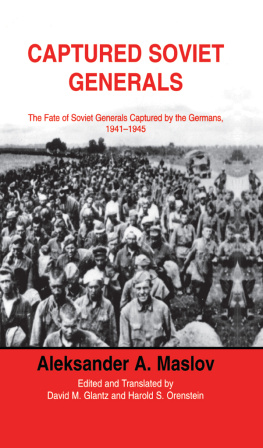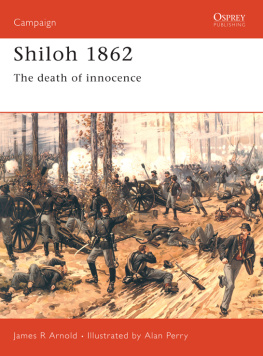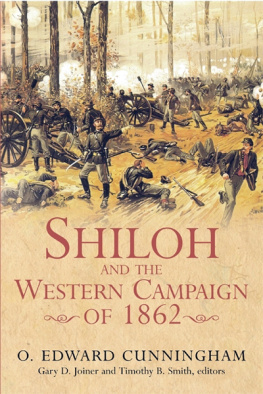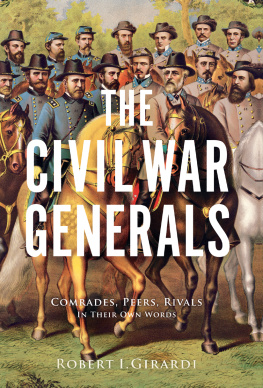Copyright 2017 by Larry Tagg
All rights reserved. No part of this publication may be reproduced, stored in a retrieval system, or transmitted, in any form or by any means, electronic, mechanical, photocopying, recording, or otherwise, without the prior written permission of the publisher.
Library of Congress Cataloging-in-Publication Data
Names: Tagg, Larry, author.
Title: The Generals of Shiloh: Character in Leadership, April 6-7, 1862 / by Larry Tagg.
Description: First edition. | El Dorado Hills, California: Savas Beatie LLC, 2017. | Includes bibliographical references and index.
Identifiers: LCCN 2017031695| ISBN 9781611213690 (alk. paper) | ISBN 9781611213706 (ebk.) | Mobi ISBN 9781611213706 (mobi.)
Subjects: LCSH: Shiloh, Battle of, Tenn., 1862. | United StatesHistoryCivil War, 1861-1865Biography. | GeneralsUnited StatesBiography. | GeneralsConfederate States of AmericaBiography. | Command of troopsHistory19th century.
Classification: LCC E473.54 .T34 2017 | DDC 973.7/31dc23
LC record available at https://lccn.loc.gov/2017031695
First Edition, First Printing
Savas Beatie LLC
989 Governor Drive, Suite 102
El Dorado Hills, CA 95762
Phone: 916-941-6896
(web) www.savasbeatie.com
(E-mail)
Our titles are available at special discounts for bulk purchases. For more details, contact us at .
Unless otherwise noted, all photos courtesy of the Library of Congress , National Archives , or Generals in Blue and Generals in Gray .
Introduction
C haracter is both the archer and the bow that gives flight to the arrow whose arc describes a human life. Storytellers instinctively know the importance of character. Character is the engine of every great story.
Military history is too often limited to strategy, tactics, weaponry, and supplies. Battles, particularly, present a chaos so intense that merely describing events and sorting out causes and effects is an immense task. Historians must devote so much effort to faithfully reconstructing a battles events that mens characters are often too little mentioned. However, if we look at the history of a battle as might a weaver plying his trade, events are only the warp threadsthe threads running lengthwise through the narrative. In order to make a whole cloth, the soldiers character must provide the woof threadsthe threads drawn through, inserted over and under the eventsthat complete the fabric of the battle narrative. The stories of the men in this bookthe leaders of brigades, divisions, corps, and armies that came together on April 6 and 7, 1862, near Pittsburg Landing, Tennesseeare meant to provide the threads necessary to create the whole fabric of the story of the Battle of Shiloh at the climax of the first year of the Civil War in the West.
The biographical approach to Shiloh is also valuable as a snapshot of American culture, fourscore and six years after the countrys birth. The color and diversity of the battles generals provide a kaleidoscopic view of the society of the period. The United States in 1860 was an young nation with a small standing army. When war broke out in Charleston Harbor in April 1861, hundreds of new generals had to be minted to command hundreds of thousands of new soldiers. These new chieftains were not professionals, but were elevated very quickly from a hodge-podge of street-level occupations. Of the 66 brigade-and-up leaders at Shiloh presented in this study, only 14 were serving as career soldiers one year before the battle when Fort Sumter fell. Thirteen more were lawyers, prominent in their communities and well-connected. Thirteen were politicians, including the previous vice president of the United States who now served in the Confederate Army. There were five businessmen (including an Iowa hatter), four plantation owners, two professors, a millwright, a sheriff, a blacksmith, a riverboatman, a geologist, a horse breeder, a bishop, a newspaper editor, a farmer, a cotton broker, a stagecoach operator, a bridge engineer, a Navy ordnance officer, and an architect. The most famous of them all, Ulysses S. Grant, was clerking at his fathers dry goods store in Illinois.
A study of the generals of Shiloh also helps illuminate the entire history of the Western Theater in the first year of the war. This obscure woodland in western Tennessee was the improbable rendezvous of more 100,000 Americans. They were men who had fought in and brought experience from every engagement in the Western Theater over the previous twelve months, at a moment when the momentum of Union victory seemed irreversible. Grant would later write:
Up to the battle of Shiloh I, as well as thousands of other citizens, believed that the rebellion against the Government would collapse suddenly and soon, if a decisive victory could be gained over any of its armies. Donelson and Henry were such victories. An army of more than 21,000 men was captured or destroyed. Bowling Green, Columbus and Hickman, Kentucky, fell in consequence, and Clarksville and Nashville, Tennessee, the last two with an immense amount of stores, also fell into our hands. The Tennessee and Cumberland rivers, from their mouths to the head of navigation, were secured.
The stories of the generals of Shiloh must necessarily include these previous episodes.
Overwhelmingly, however, Shiloh was a meeting of masses of young men, many of whom had never fired a gun in anger. Some of the new recruits had just received the first muskets they had ever held. That they fought so hard and so well for two long days in dense, ravine-crossed woods, under mostly amateur officers, is a mark of the intensity of their will to fight. That neither side could force a crushing victory is a mark of the balance of their abilities. Of the character of the men in the two opposing armies, Grant wrote his opinion that It is possible that the Southern man started in with a little more dash than his Northern brother; but he was correspondingly less enduring.
The battle of Shiloh draws its interest in part because it is the story of the bloody meeting of not two armies, but three. It was the violent rite of passage of all the major armies of the Western Theater of the Civil War, and eachthe Army of the Tennessee, the Army of the Ohio, and the Army of the Mississippihad passed through its birth and early growth in its own peculiar way. Each was an accretion of regiments and batteries that had been added sometimes singly, and sometimes, as in the few weeks immediately leading up to the battle, in great numbers. More, each regiment of those armies that threaded its way through the first year of the war toward the rendezvous on the Shiloh plateau arrived with its own story. Even in this earliest of the major battles of the Civil War in the Westand the battle of Shiloh marks, within one week, the end of the first year of the warthe officers who commanded their brought with them their own unique background of experiences. None had yet fought a battle on the epic scale of Shiloh, but each man and command had traveled their own winding road to get there.
The use of character-as-history also invites the reader to find new stories that havent yet been explored in Civil War literature. Sometimes a collection of stories, even short ones such as those found here, suggests its own themes. Sometimes it sparks new insights. In every case, it will be the characters, as well as the events, that enchant the reader.









